Make Your Own Healing Calendula Oil: amazing natural medicine for your skin!
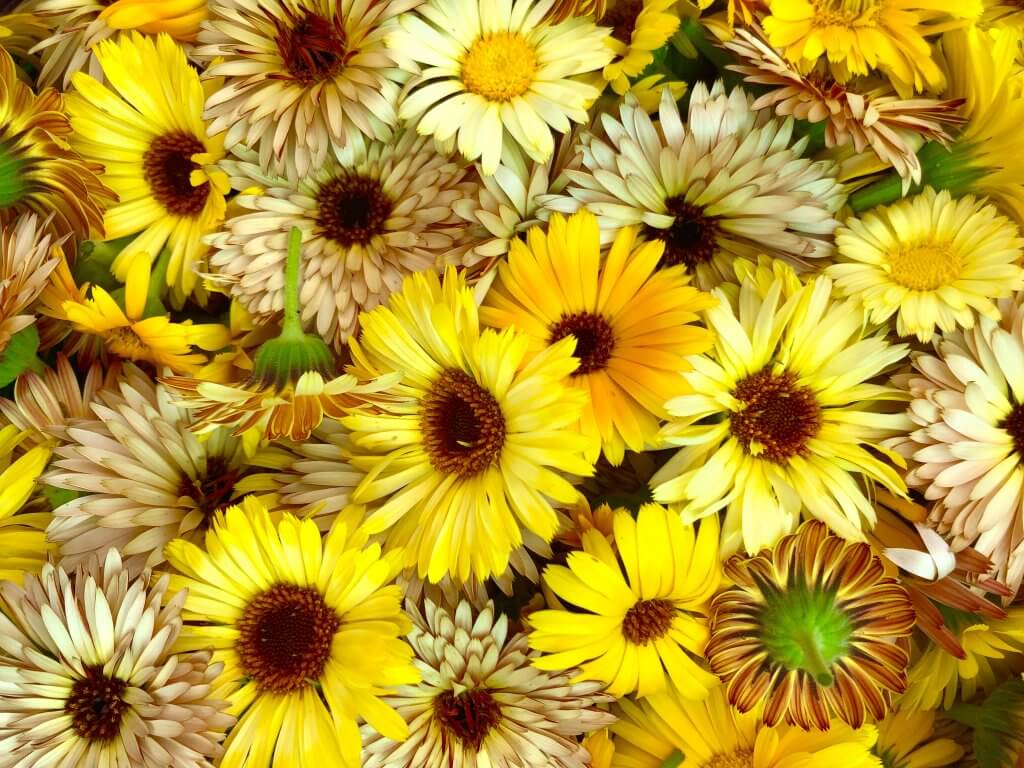
Firstly: I present my case
I planted so much Calendula this year that I’m determined to learn about all the good things I can do with it. And–lucky you, gentle reader–I’m going to share everything worth sharing with you. In this post, I’ll share with you several ways to use Calendula as a beneficial herb, and how I make my healing Calendula oil. You can use this oil as-is, or make it into salves and creams.
Why do I need Calendula oil or creams or salves? That is your part.
Read on, gentle reader. Read on.
Simply: calendula works its magic by promoting cell repair and growth, and has natural antiseptic, anti-fungal, and anti-inflammatory properties.Herbalists, homesteaders, and natural healers have used Calendula officinalis for centuries. You can use it both internally or externally to support the immune system, treat skin ailments, and heal infections.
And. Importantly, calendula is gentle in its work. Unlike some natural remedies, you don’t need to worry about “overdoing it” with this herb.
Secondly: A day in March & a Ponder that lasted
One day in March of 2020, I walked into our local Walmart to see ransacked store shelves for the first time in my life, as shortages of basic supplies like aspirin, toilet paper and canning lids became a new reality for many of us. I drove home and took a walk around our little acreage, a little stunned by the experience.
I had an epiphany. (You may want to sit down.)
Here it is: in our twenty-first century affluence, when we can run to the store at any hour for just about anything we might need (and order everything else online), we have learned to ignore the miraculous natural world all around us, and its truly amazing contents.
My own little Swedish Grandma used to show us around her tiny yard and point out plants to us, and explain what they were good for: dandelion’s bitter greens cleansed the blood, she said. The milky white sap from the stem of milkweed treated warts (it works). The impossibly-soft leaves from the wooly lamb’s ear plant can be used as a bandage: it’s antibacterial and antiseptic, and will not only protect a scrape but will also help heal it. Plaintain leaves could be chewed up, in a pinch, and the resulting goop be applied to an insect sting or bite. (It works, too.)
What must God think of us? The Creator of such wonders as Calendula, Wooly Lamb’s Ear, Plaintain, Mullein, and so many other nutritious, delicious, healing products that grow like weeds (actually, most of them are classified as weeds) all around us, and which most of us completely ignore in our rush to get to the store for our salad, our band-aids, our store-bought medicines?
Thirdly: We are so weird.
It’s a huge blessing, of course, to be able to purchase many things very close to our home. Or is it? With just a little bit of effort and time, and a little foreknowledge, most of us would be able to harvest and produce valuable products from our yards and even from the roadsides and ditches, many of them superior to any store-bought products.
It really boggles my imagination.
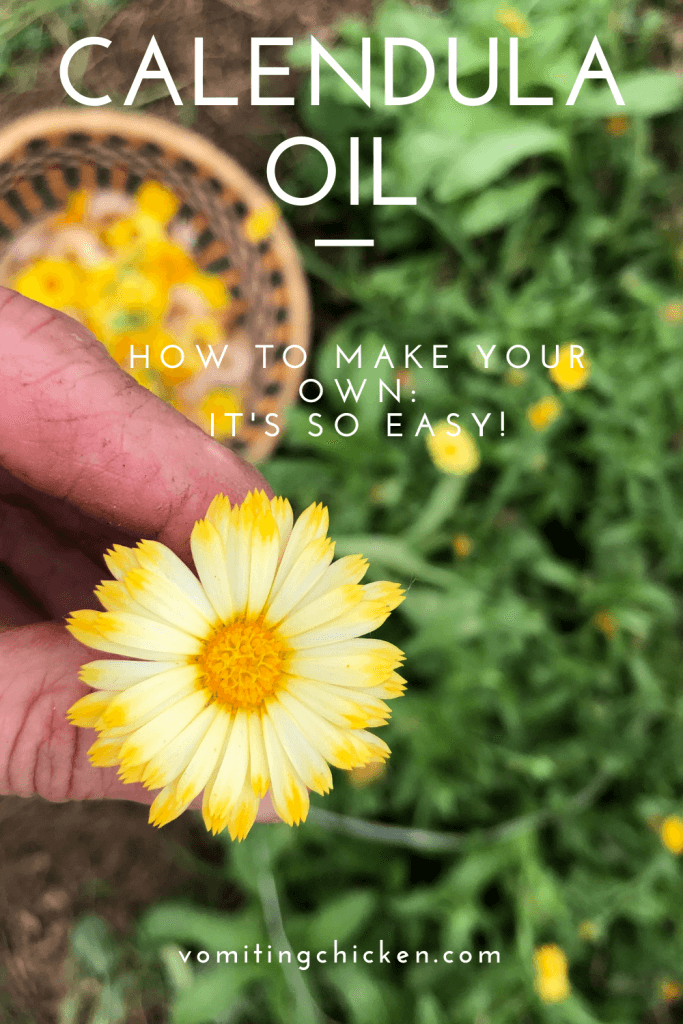
To wit, more random weirdness:
- I carefully pick each of my (lovely, fussy, and difficult to grow) blueberries, as the (wild, super-nutritious, abundant) mulberries fall off the trees onto the path to be eaten by wild birds and my totally spoiled chickens. Weird.
- I grow a lovely (domesticated, fussy, prone to bolting) dandelion for greens, while the (wild, nutrient-dense, perennial) dandelions in the yard grow and propagate with no care at all. With wild abandon, in fact. How peculiar.
- I planted squash in a wild area that wants to revert to wild things (in the commonsensical way of wild things): prairie grass and the largest mullein plants I’ve ever seen: taller than me! Should I pull the huge mullein plants to allow the fussy squash plants to produce, or leave the wild plants be, and use them to produce many years’-worth of beneficial ear drops and lung-supportive tea (for starters)? (Mullein has been used for centuries in these beneficial uses, while we now go to Walmart for ear drops and tea, which leads me to believe that we are not as smart these days as we think.) Curious and peculiar and weird.
I could go on and on. (And: I just might!) But you get the idea. We are literally surrounded by astounding beneficial and miraculous plants but most of us have forgotten how to use them–or we never knew in the first place. (My grandma knew! Yours probably did, too.)
Fourth: a Few Calendula Basics
And that brings us back to the subject at hand: Calendula. (By the way, you can pop over here for Calendula growing instructions.)
It is:
- super easy to grow
- actually–an herb!
- enthusiastically self-seeding
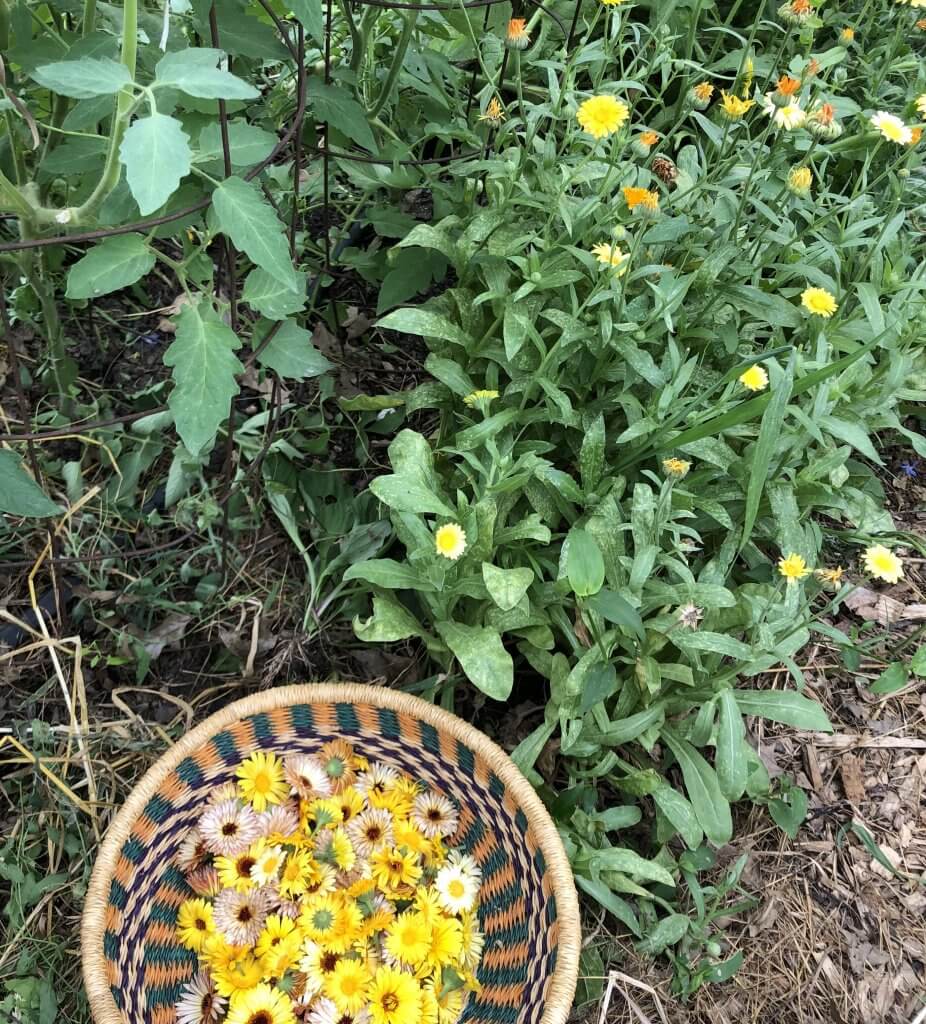
These are volunteer calendula plants, growing cozily amidst my tomato plants.
. . . with a few usage TIPS:
- For optimal strength in your calendula oils and salves, use the whole flower—including the sticky green flower base—instead of the petals only (the herb is sometimes sold this way).
- Mamas, don’t use calendula internally during pregnancy since it has traditionally been used to bring on menses.
- Calendula may cause a reaction for people who are highly sensitive to plants like ragweed (Ambrosia spp.) and chamomile (Matricaria recutita). This possibility is very rare, but sensitive individuals should proceed with caution when using calendula for the first time.
- Rare incidences of allergic contact dermatitis have occurred with the topical use of calendula.
- Use just a small amount of calendula at first, to make sure that you aren’t one of the unlucky few who might have an adverse reaction to it, like you would with any new herb or plant. Common sense, folks.
A bit more ballyhooing about Calendula, and then I’ll get to the juice of this post, which is an easy recipe to make your own skin-healing Calendula oil.
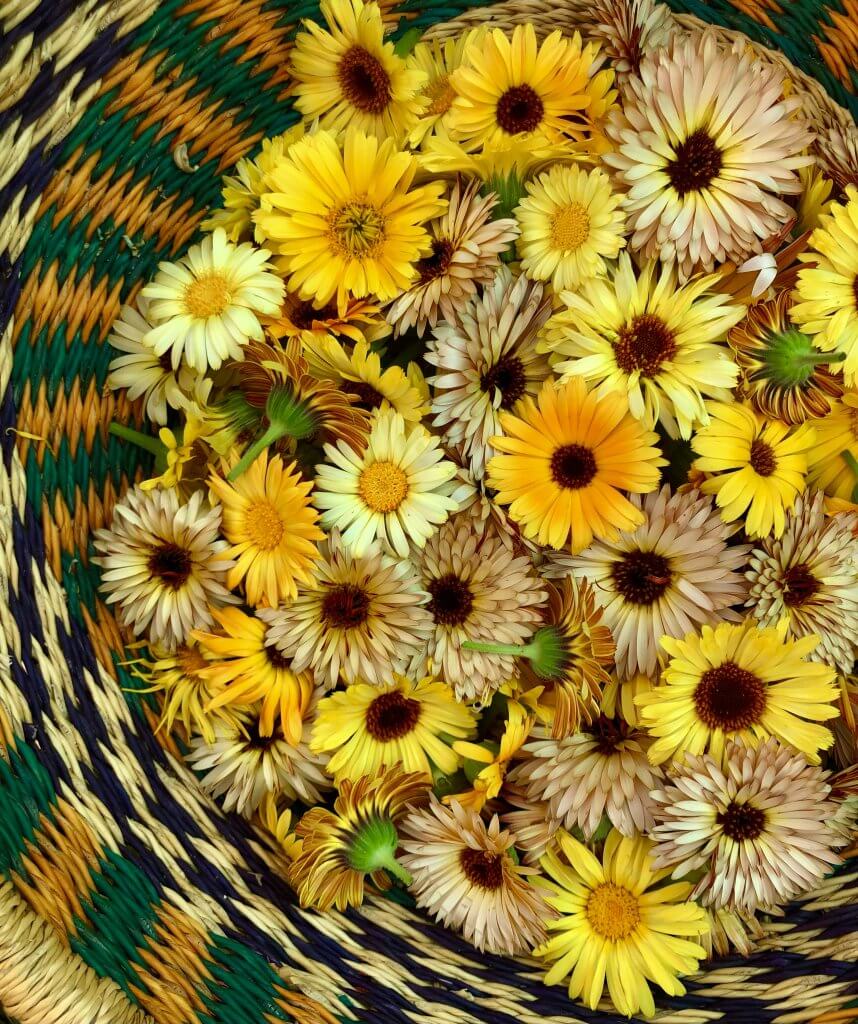
Fifth: Calendula in healing the skin and more
Calendula can be used to treat the following skin conditions:
-
- Rashes
- Stings
- Wounds
- Burns
- Sunburns
- Abrasions
- Swellings
- Eczema
- Acne
- Insect bites
- Scrapes
- Bruises
- Chicken pox
- Cold Sores
- Cracked nipples (from nursing)
- Postpartum perineal tears (sitz baths)
Additionally, Calendula has been used to treat:
- Sore throats
- Ulcers
- Fevers
- Insomnia
- Many other maladies
Calendula’s Herbal Actions:
- Vulnerary (wound-healing)
- Anti-inflammatory
- Antimicrobial
- Antifungal
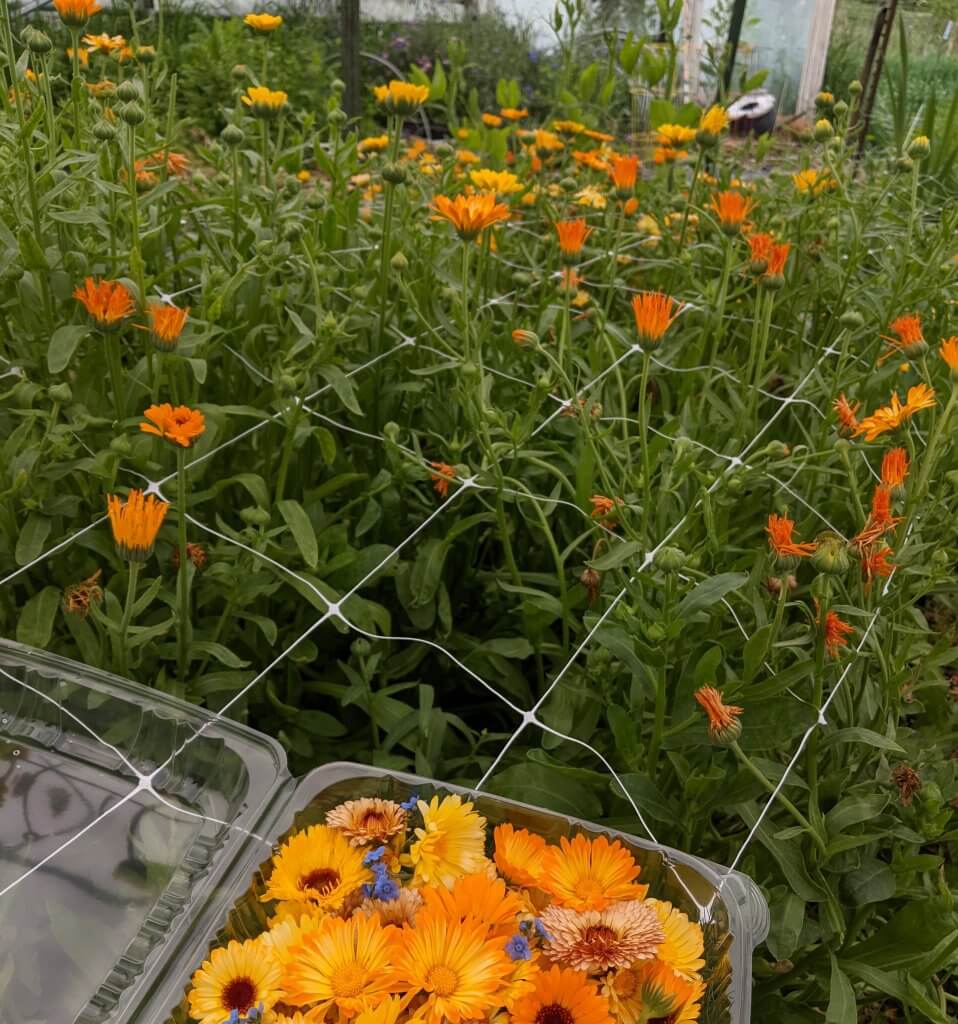
C. Officinalis in excess, ha!
Sixth: Regarding C. officinalis
Basically, there are a lot-–around 25, actually–of varieties of the genus Calendula (Asteraceae), and the one that I’m referring to today is the one that is often called “pot marigold” or C. officinalis. Among the various species of the genus Calendula, C. officinalis is the only one which is extensively used clinically throughout the world.
There has been research (you can find links to it here) done on C. officinalis, mainly in infusions, tinctures and ointments used as wound healing remedies for inflammations of the skin, mucous membranes, and for poorly healing wounds, bruises, boils, and rashes, etc.
Impressive, eh?
Seventh: Where to buy Calendula if you need to
As mentioned previously, take care that you use the whole dried flowers when making oils and salves, as calendula’s medicinal resinous oils are found mostly in the involucres (green bases of the flower heads). Sometimes calendula is sold as “petals” only; this is a weaker medicine for topical use.
If you don’t grow calendula yourself, no sweat! You can purchase dried calendula flowers through Mountain Rose Herbs (affiliate link). Actually MRHerbs have scads of calendula products, including calendula extract.
(Oh! And through the month of July, all essential oils at Mountain Rose Herbs are 20% off! (affiliate link) It’s a great time to stock up for the fall and winter season, natch’! This discount ends on July 30th, so hop to it and save some cash on your essential oils stash!)
Eighth: deciding whether to use oils or water-based
When to use a water-based product rather than oils or salves:
In certain situations, the application of herbal oils and salves is not recommended. Oils and salves hold in moisture and heat and thus shouldn’t be used on weepy skin conditions, infections, and fresh burns. (Source)
Avoid the use of oils and salves on
- poison ivy rashes
- weepy eczema
- pimples and boils
- fresh sunburn
- fungal and bacterial skin infections
- deep wounds and cuts
Instead of oil-based preparations, use water-based applications such as herbal compresses, soaks, baths, and poultices.
Oil infused with dried calendula can be massaged directly onto dry, irritated skin or used as an ingredient in recipes for salves, lotions, creams, soaps, and lotion bars. The shelf life of strained, infused oil is around 1 year. It’ll last two or three years, however, if you keep it tightly lidded and in your refrigerator.
Summertime around here is a synonymous with sunburn, chigger bites, mosquito bites, nettles stings, and other itchy, rashy, irritating conditions. (I’d take a picture of my arms and legs to share with you, with all the scratches, stings and bites, if it wasn’t so gross!) It’s just part of the season for us country folk (apparently).
Mack–after years of being a naysayer where nettles stings are concerned (as in: Stinging nettles don’t affect me, tra-laaa!) actually had a reaction to them the other day, much to the astonishment of both of us! He looked at me with different eyes after I carefully applied calendula oil to the stinging nettles welts on his arm.
He didn’t say anything, but I could tell what he was thinking. Because I’m his mom and it’s a mom perk, the ability to read one’s child’s mind.
“Mom’s a real wonder, a treasure!” his eyes said (Surely that was it). “She raises these cool medicinal flowers and I’ll never complain again about having to help in the garden! Ever–ever–ever!”
Then he jumped up and asked me if there was anything at all that he could do for me, as his afternoon was relatively free. (harhar)
Finally: Are you Ready?
How to make Calendula-infused oil
*cymbal crash!*
Making your own calendula oil is easy as one-two-three.
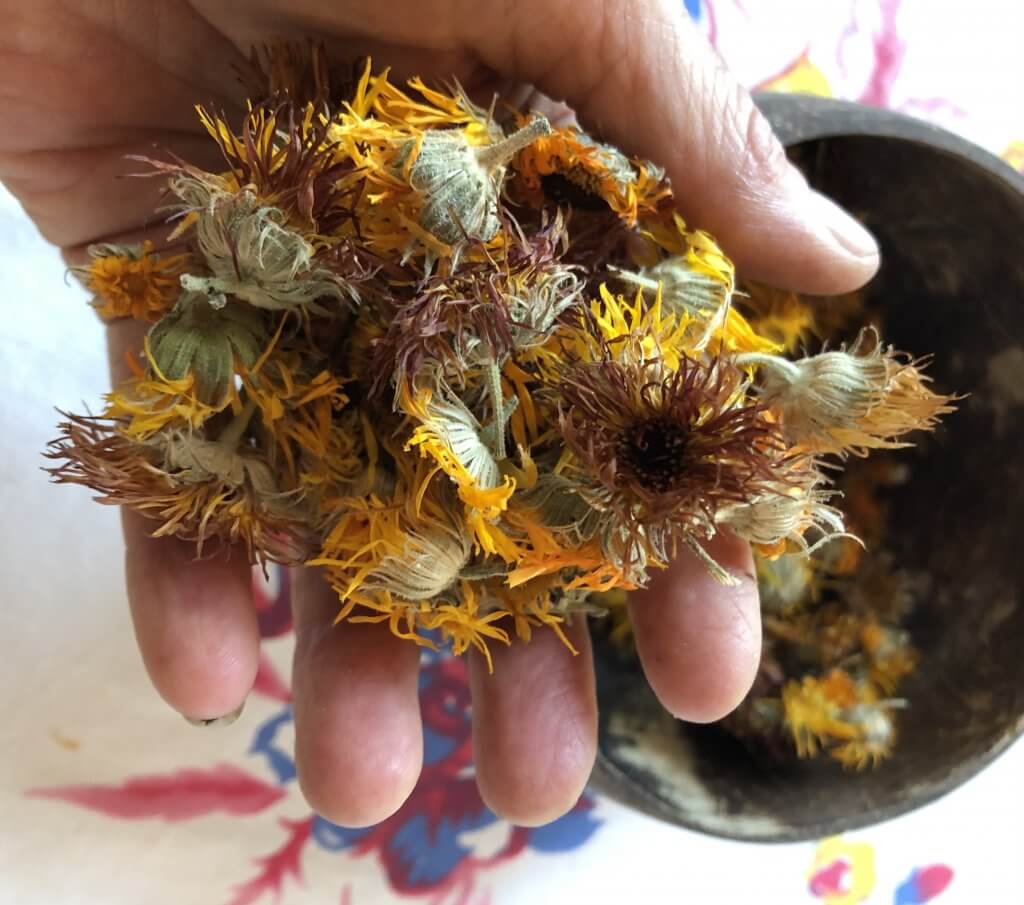
Completely dried-out flower materials will not mold in your oil.
Here’s how you do it.
First, gather the following:
- 1 cup whole dried calendula flowers (Calendula officinalis)
- 1 cup extra-virgin olive oil (that’s my choice, or you can substitute jojoba or almond oil)
Yield: approximately ¾ cup
Note: You can double or triple this recipe by following the same proportions outlined above: 1 part herb by volume to 1 part oil by volume. And I adapted this recipe from the one I found here.
Preparation:
Step 1: Dry your herbs. If you’re using homegrown or gathered herbs, gather your flowers and dry thoroughly. (I put mine out on our deck, in the shade, and it only took a couple days for them to get nicely dried.) If you buy dried herbs, make sure they are fresh and high quality. Tip: It’s important to remember that oil can ferment or mold in the presence of water. If you are new to preparing medicinal oils, I recommend using dried herbs rather than fresh herbs. You’ll also want to make sure all your tools are completely clean and dry.
Step 2: Combine the whole dried flowers with your oil of choice in a blender or food processor. Shoot for a thick, pesto-like consistency. This increases the surface area of the herbs, leading to a stronger, more concentrated oil.
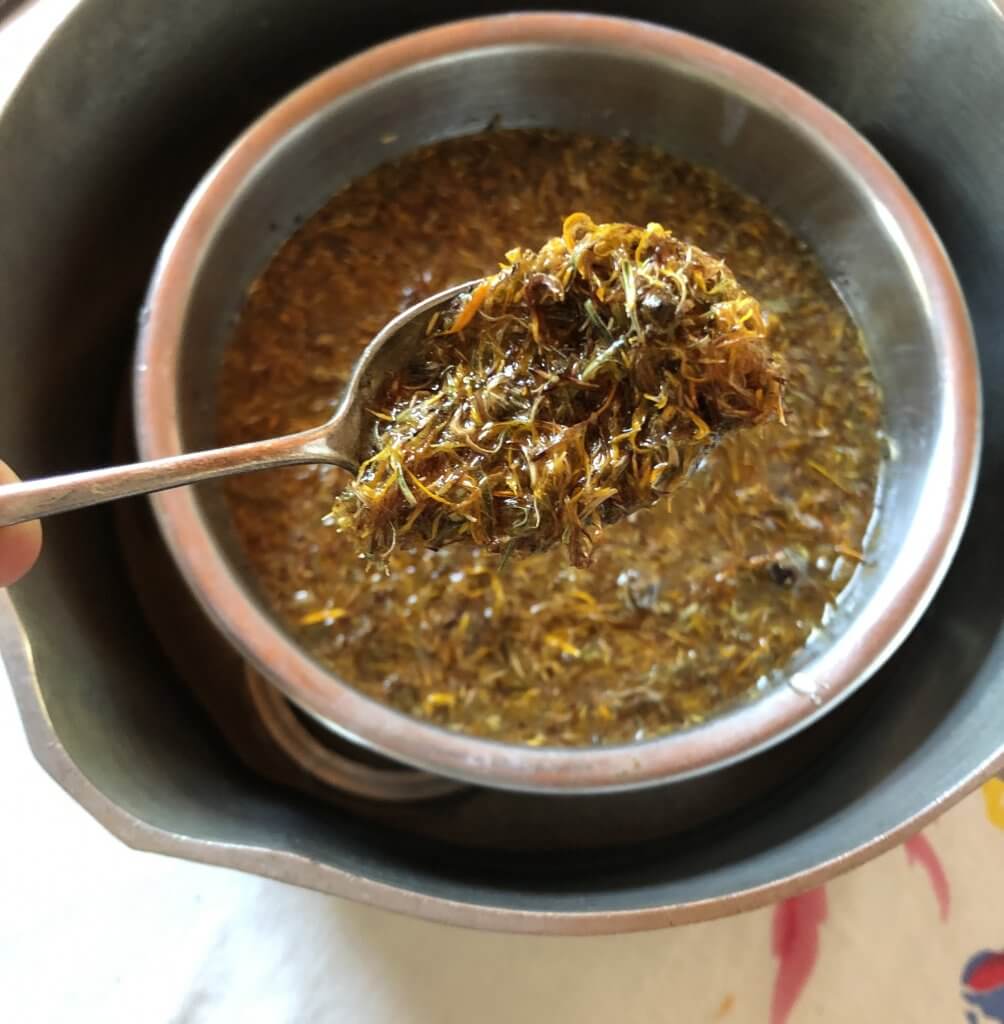
After a few hours of gentle heating, your calendula oil will be ready to strain.
Step 3: Heat the herb/oil mixture in a double boiler for four to eight hours. If you–like me–don’t possess a double boiler, you can improvise by nesting two pots together or placing mason jar bands upside down in a saucepan filled with water, with a bowl on top of the bands. The trick is to nest one pan (for your herbs and oil) inside the other (filled with water) without the bottoms touching.
Heat slowly and keep on low heat for four to eight hours. Try not to let the oil get hotter than 110°F, or 43.3°C (a little warmer than bath water). Watch closely to make sure the water does not completely evaporate and the oil does not get too hot.
I do this sort of task when I have other things going on in the kitchen–making supper, pitting cherries, unloading the dishwasher, making bread, etc.
Step 4: Strain your oil. After your oil has infused for four to eight hours, place cheesecloth or a fine weave cloth in a stainless steel or ceramic strainer and pour in the oil-herb slurry. After the oil ceases to run through the cloth (I let mine sit overnight) wring out the herbs with clean, dry hands or press with a potato ricer.
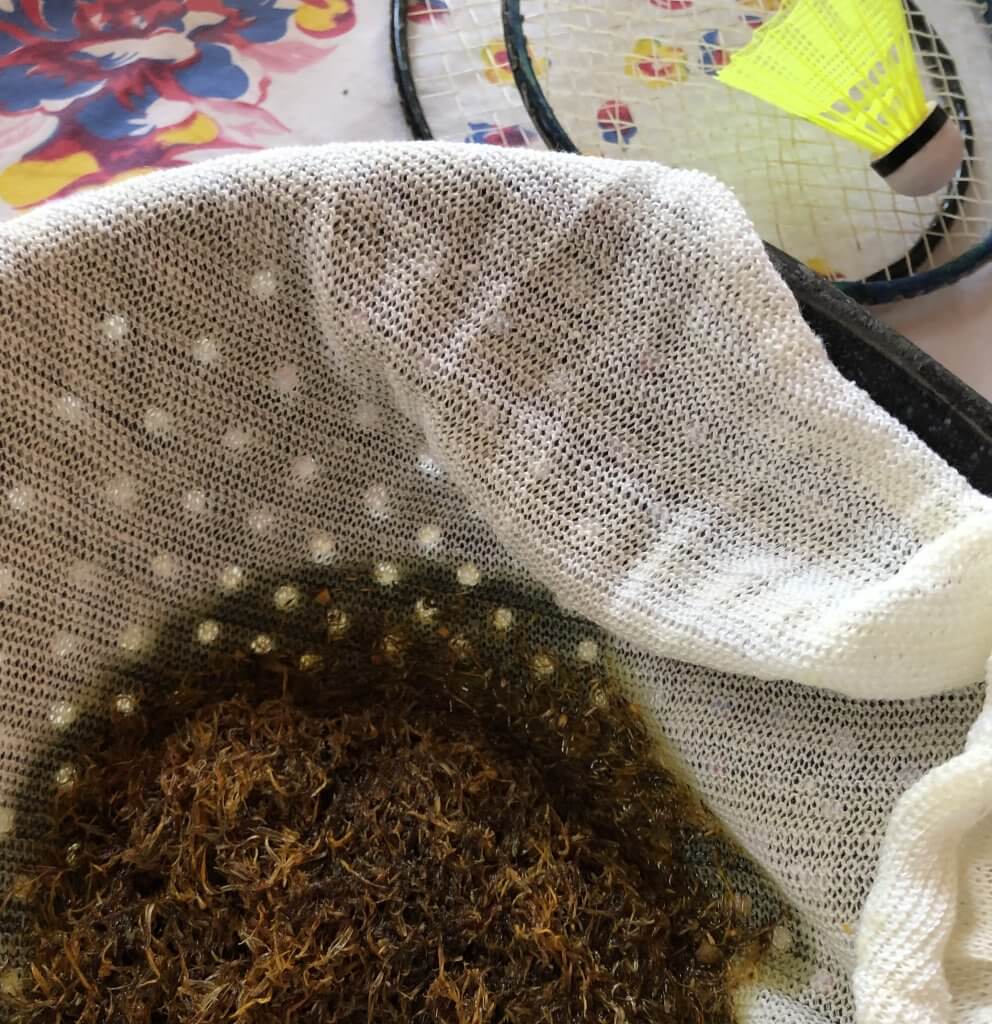
You won’t have to put off your evening badminton game very long; it takes just seconds to pour your calendula slurry into a collander lined with cheesecloth.
Step 5: Label and store. Make a label! Make a label! <—this is for me, as well as you. (If I forget the label, I forget the contents. Period. Almost immediately.) (You don’t want to be rubbing your basil vinaigrette on your mosquito bites, now, do you??) (And drizzling calendula healing oil onto your salad?) Cap your oil when it cools to room temperature (this prevents condensation from developing inside the jar). Herbal-infused oils will typically last two to three years when refrigerated and one year unrefrigerated, depending on the stability of the oil you use.
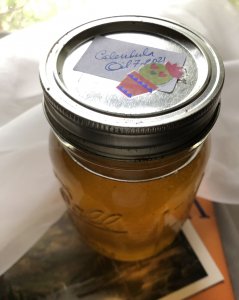
See–I remembered to label it!
That’s it, baby!
A new thought!
Now. I’m trying not to think about it (because the powers of my imagination always vastly exceed the time I have to take on new projects!) but you can think about it for me: Dainty little jars of “Calendula Healing Oil,” nicely labeled and tucked into everybody’s stockings at Christmas . . . ooh la laa!
I can see it . . . she whispers to herself . . .
Thanks so much for popping in, gentle reader. Do me (and yourself!) a favor and jot your email address in the little box underneath my face, up to the right. You’ll get a note in your inbox every time I publish any new posts. How nice for both of us to stay in touch!
And don’t forget the sale through July over at Mountain Rose Herbs. 20% off all Essential Oils: fabulous!
Take care. Be brave. Don’t let anybody talk you into being afraid!* Floss your teeth. Do something you absolutely love every day. Hug your loved ones and count your blessings.
*hugs*
*Remember: “For God has not given us the spirit of fear; but of power, and of love, and of a sound mind” -2 Timothy 1:7


Amy – I think you should be selling your calendula oil since millions of folks who were stuck at home and bored out of their skulls a year ago are now going back to work and may not have time to grow their own flowers and make their own calendula oil.
Very helpful and informative posting!
Thanks, Gene. I’d better keep clipping the calendula blossoms then!
Love this. Off to order calendula flowers as soon as the monthly budget turns over.
Perfect. And if you want some seeds, friend, I’d be happy to save you some for next year.